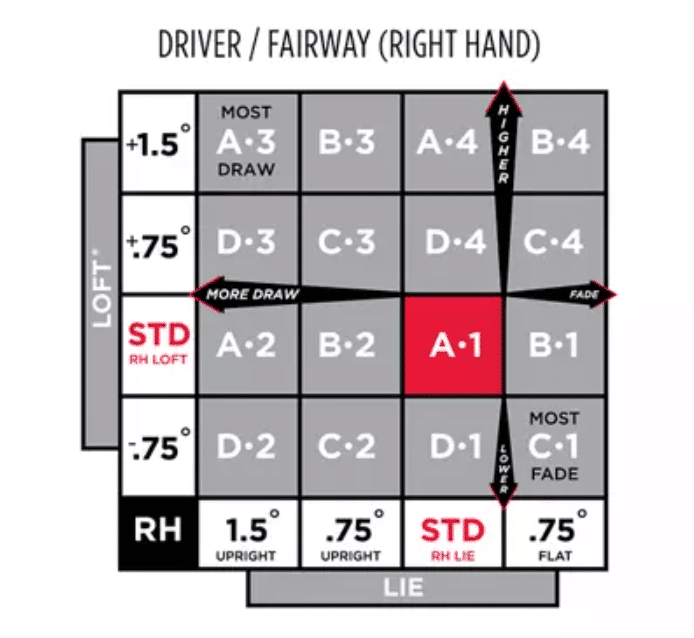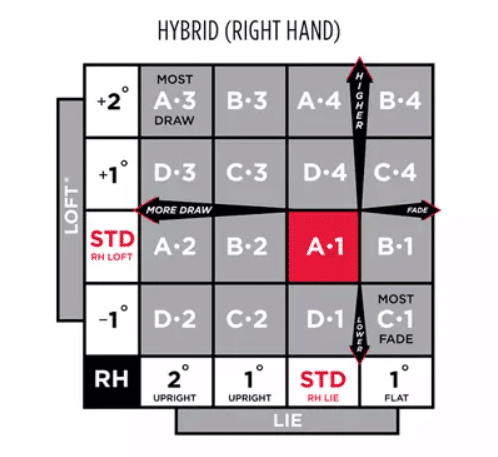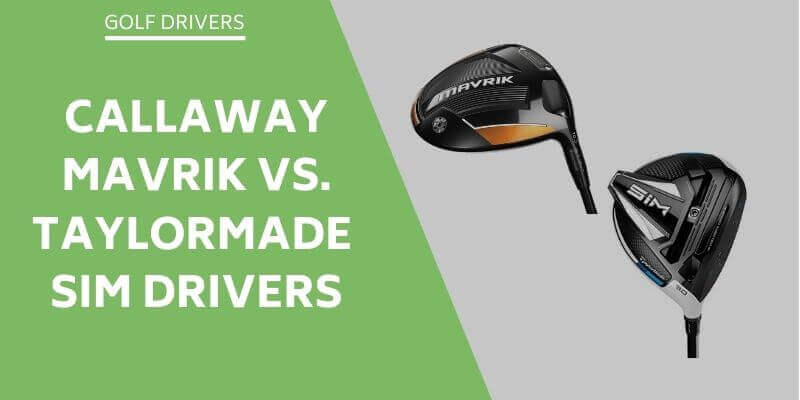Titleist has long been an innovator in the equipment space. Titleist is a leader in the golf industry, from the number one played ball on tour to trusted drivers, irons, and wedges.
Their drivers are among the best you can get and highly customizable.
Titleist driver settings give you complete control of your loft and lie angle, enabling you to cater your driver to your unique swing. The SureFit hosel, which allows for these changes, has 16 loft and lie angle combinations to choose from. You can use the Titleist adapter chart to help with configuration.
In this article, I will cover all you need to know about settings for Titleist drivers equipped with the Titleist SureFit hosel. Topics you will learn include:
- Understanding Titleist driver settings
- How to optimize your launch angle using the Titleist driver adjustment chart
- Adjusting your spin rate
- Fine-tuning your ball flight
- Maximizing distance with your Titleist driver
There is no substitute for working at improving your skills as a golf. However, golfers can take full advantage of what equipment technology offers them, regardless of skill level. Understanding how to use that tech, and in the case of this article, using the proper driver settings can help you a great deal.
The benefits of adjusting your Titleist driver settings include a potential increase in consistency and distance. These are both attributes all golfers can use within their games.
Understanding Titleist Driver Settings
As mentioned previously, Titleist is one of the foremost leaders in the equipment industry. In terms of their most recent driver offerings, you have the TSR family of drivers. They include:
- TSR1 driver: An ultra-lightweight driver for moderate swing speeds.
- TSR2 driver: For players who make contact across the entire surface of the face.
- TSR3 driver: For players with a consistent impact location.
- TSR4 driver: For players that generate too much spin.
All of these drivers offer a Titleist SureFit hosel. This piece of tech gives a golfer several loft and lie angle options, and you can use the Titleist loft chart to ensure you configure yours accurately.
The SureFit hosel features a sleeve and ring, each with four settings. The sleeve settings are numbered 1, 2, 3, and 4, and the ring settings are lettered A, B, C, and D. There are 16 unique loft and lie angle combinations. Below you’ll find the loft chart to use. Important to note: this is the chart for right-handed players. If you’re a lefty, use the left-handed chart instead.
Starting from the A-1 setting, the standard loft and lie setting, you would move up to D-4, and potentially A-4 for a higher launch. Conversely, you move down to the D-1 setting for a lower trajectory. These changes adjust your loft.
To adjust the lie angle, you would move left according to the Titleist driver chart if you’re seeking a draw bias. You would move right on the Titleist hosel chart to favor a fade bias.
The video below explains this further.
How to Adjust the SureFit Hosel
Once you’ve identified your desired setting on the Titleist driver settings chart, insert the SureFit wrench into the hosel screw and rotate counter-clockwise until the hosel becomes loose. From there, you will move the adjustment ring to the desired setting. Tighten the screw clockwise until you feel and hear the wrench “click.”
More From Golf Span: What Driver Loft Should You Use? (Full Chart Based On Swing Speed)
How to Optimize Your Launch Angle
According to Trackman, launch angle is:
“The vertical angle relative to the horizon of the golf ball’s center of gravity movement immediately after leaving the club face.”
For a driver, as pointed out by Trackman, there are several averages that golfers of different skill sets launch their driver. When set correctly, the adjustment will give you your optimal launch angle
Two significant factors that affect launch are clubhead speed and ball speed. Generally, better players can produce higher clubhead and ball speed numbers. With that, they can have a more optimal launch with each club and have longer carry distances.
According to Trackman data, here are average launch angles for a driver and how they match up with skill level.
| Male | Ave. Driver Launch Angle | Female | Ave. Driver Launch Angle |
| PGA TOUR | 10.9 degrees | LPGA Tour | 13.2 degrees |
| Scratch or Better | 11.2 degrees | Scratch or Better | 12.7 degrees |
| 5 HDCP | 11.2 degrees | 5 HDCP | 12.0 degrees |
| 10 HDCP | 11.9 degrees | 10 HDCP | 12.4 degrees |
| Average Golfer (14.5) | 12.6 degrees | 15 HDCP | 13.6 degrees |
| Bogey Golfer | 12.1 degrees | N/A | N/A |
One benefit of Titleist driver adjustment options is that you can change and experiment with different lofts. Regardless of whatever standard loft your driver starts with, you can adjust that up by .75 degrees and 1.5 degrees. You can also decrease the driver’s loft by .75 degrees.
Doing so lets you have a driver in hand that will help you optimize your personal launch conditions.
Pro tips for improving your launch angle with your driver:
- Move your ball position up for higher launch, or back for lower.
- Tee your ball up for higher launch, or lower for lower launch.
- Increase your secondary spine angle for a higher launch angle.
- Level your shoulders out, or decrease your secondary spine angle for a lower launch angle.
Adjusting Your Spin Rate
According to Trackman, spin rate is:
“The rate of rotation of the golf ball around the resulting rotational axis of the golf ball immediately after the golf ball separates from the club face.”
For the most part, clubhead speed and spin loft determine the spin rate.
The spin loft is the difference between the club’s angle of attack and its dynamic loft at impact. Dynamic loft is the amount of loft on the clubface when it strikes the ball. That difference between the angle of attack and the dynamic loft equates to the amount of spin on the ball as it flies.
Just like with optimal launch angles, Trackman has identified optimal spin rates for drivers as well. Keeping things consistent, they once again break down average driver spin rates by splitting players into skill levels.
| Male | Average Driver Spin Rate | Female | Average Driver Spin Rate |
| PGA TOUR | 2686 rpm | LPGA Tour | 2611 rpm |
| Scratch or Better | 2896 rpm | Scratch or Better | 2831 rpm |
| 5 HDCP | 2987 rpm | 5 HDCP | 3027 rpm |
| 10 HDCP | 3192 rpm | 10 HDCP | 3207 rpm |
| Average Golfer (14.5) | 3275 rpm | 15 HDCP | 3287 rpm |
| Bogey Golfer | 3127 rpm | N/A | N/A |
Changing the loft angle on your Titleist driver will help you optimize your launch conditions and reduce your spin rate.
Pro tip for optimizing your driver spin rate:
To track where on the face you contact the ball, spray your driver with foot powder spray. The ball will leave a very obvious mark after contact. The ideal spot is just above and towards the toe of the dead center on the face. Again, working on controlling your attack angle and where on the face you are hitting the ball will help you reduce your driver spin rate.
More on Golf Span: Titleist Drivers by Year: Almost 40 Years of History
Fine-Tuning Your Ball Flight
Ball flight generally refers to the shape of the shots you hit. A shot’s height, trajectory, direction, and curvature are all part of what ball flight is in golf.
The ball flight laws dictate ball flight. What is referred to as the new ball flight laws are as follows:
Clubface (in relation to the target line) + swing path (in relation to the clubface) = ball flight
- Straight – Face is square to target, and square to a straight path.
- Straight slice – Face is square to target, and open to an outside-to-inside path.
- Straight draw – Face is square to target and closed to an inside-to-outside path.
- Push slice – Face is open to target, and open to a straight path.
- Push straight – Face is open to target, and square to an inside-to-outside path.
- Push draw – Face is open to target and closed to an inside-to-outside path.
- Pull slice – Face is closed to target, and open to an outside-to-inside path.
- Pull straight – Face is closed to target, and square to an outside to inside path.
- Pull draw – Face is closed to target and closed to a straight path.
The beauty of adjustable drivers, like in the Titleist TSR family of drivers, is that you can set the face of the club up to help with things like ball flight.
Remember, with this adjustability function to change the lie angle, you are only essentially closing or opening the clubface slightly at set up, which is just one facet of the equation. According to the ball flight laws, you will still need to swing the club in a way that will produce the shot shape you want.
Pro tip on ball flight:
This is a very simplistic tip, but I feel it is necessary to master your shot shape… study and learn the ball flight laws in depth!
Read on: The Best Titleist Drivers
Maximizing Distance With Your Titleist Driver
Here are a few of my suggestions to help you maximize your distance potential with your Titleist TSR Driver…
- Do a professional Titleist driver fitting: This is an often overlooked aspect of buying clubs. By simply doing research online and buying clubs off the rack, you will never honestly know if you have what’s right for you. Do yourself a favor and get professionally fit.
- Get the right shaft for your swing: When optimized for your swing and your tendencies, the club shaft can make a massive difference in your ability to maximize your potential driving distance. This is something that can be done in your professional fitting.
- Understand the Titleist SureFit hosel setting options: Having a good grasp of the 16 options available within the Titleist driver settings chart will help you maximize your driving distance potential.
Conclusion
While Titleist offers an incredible range of high-quality drivers to choose from, it’s largely Titleist’s driver settings that make their clubs so appealing.
We all have our own specific way of striking the ball, and getting equipment that complements our style is the best way to maximize performance. In this area, Titleist cannot be beaten.
The SureFit hosel paired with the Titleist fitting chart offers a quick and easy way to adjust your driver to 1 of 16 loft and life combinations. Talk about spoilt for choice.
Frequently Asked Questions
What Is the Best Titleist Driver Setting for Distance?
The best driver setting for distance depends on the individual golfer. Discovering your current clubhead and ball speed numbers will help in making setting decisions. So will knowing your current launch angle and spin rate.
How Do I Adjust My Titleist Driver for a Draw or Fade?
Using the Titleist SureFit chart will help guide you in changing your lie angles. There are four lies to choose from, and moving to the left will increase your draw bias while moving to the right will increase your fade bias.
What Is the Optimal Launch Angle for a Titleist Driver?
The optimal launch angle is something that depends on the individual golfer. A golfer's clubhead speed will be a significant factor in what launch angle would best maximize their capabilities.
How Do I Adjust My Titleist Driver for Different Course Conditions?
If a course is firm and fast, you should take advantage of that by lowering your launch angle. This will help the ball roll out more and give you more distance.
If the course is wet, adjust the loft to launch the ball higher so you carry it more.
Wind can also be a situation for considering changing your loft settings.
How Often Should I Adjust My Titleist Driver Settings?
This, too, is all based on the individual. Some golfers may find that changing is necessary before each round based on how they hit the ball in warm-ups. Others may want to stick to one setting and only change if course conditions dictate so.
What Are the Driver Settings of the Titleist Driver TSI and TS2?
Both clubs come equipped with the SureFit hosel system, so the Titleist TS2 driver’s settings and the Titleist TSI’s driver settings are the same. They have a combination of 16 loft and lie angles to choose from.
Do Titleist Hybrids have Adjustment Charts?
Titleist charts aren’t unique to their drivers. They also have two Titlist hybrid adjustments charts as well, one for righties and one for lefties. Their hybrids allow for -1 to 2 degrees of loft and 2 degrees upright to 1 degree flat when it comes to lie.
Brendon is Class A PGA Professional and founded Little Linksters, LLC, and its nonprofit arm, the Little Linksters Association for Junior Golf Development. He won 25+ prestigious industry honors, including the 2017 PGA National Youth Player Development Award. He graduated from the PGA of America Management Program and has a handicap index of 7.8.
He has played golf for over 40 years and currently plays twice a month at the Eagle Dunes Golf Club near Sorrento, Florida. He loves Srixon clubs and plays a ZX5 driver with Z 585 irons. He's written over 60 articles on GolfSpan and specializes in sharing tips to improve your golf game. You can connect with Brendon at LinkedIn, X, IG, FB, his website, or BrendonElliott@pga.com.









